 (2.86 avg; 11 ratings) rate it
(2.86 avg; 11 ratings) rate it
 (2.47 avg; 65 ratings) rate it
(2.47 avg; 65 ratings) rate it
 (3.60 avg; 29 ratings) rate it
(3.60 avg; 29 ratings) rate it
 (3.24 avg; 19 ratings) rate it
(3.24 avg; 19 ratings) rate it
 (2.81 avg; 34 ratings) rate it
(2.81 avg; 34 ratings) rate it
Amanda Rafkin & Ross Trudeau’s New York Times crossword—Amy’s write-up
Theme revealer: 54a. [Network of personal relationships … or a punny hint to 3-, 7- and 11-Down], SOCIAL CAPITAL. Familiar phrases are clued as if they’re about actions on social media that relate to finance terms:
- 3d. [Joins a Federal Reserve Facebook group?], FOLLOWS THE MONEY.
- 7d. [Uploads a photo of a government security?], POSTS BOND.
- 11d. [Retweets a photo of the U.S. gold repository?], SHARES THE WEALTH. Bring it to me!
I like the theme contents okay, but not the unusual layout in L/R symmetry. Having a 9-letter themer sandwiched between two nonthematic 9s is awkward, as is including a beefy 11-letter Across answer, WIPER BLADES, that at first glance looks like it should be a theme entry. It’s cleaner to keep the non-theme fill shorter than the themers, particularly in the same direction.
Five more things:
- 16a. [Primary ingredient in the snack Muddy Buddies], CHEX. Chex cereal and chocolate, those are the main components here. Num.
- 53a. [“The Pit and the Pendulum” author, in brief], E.A. POE. Will constructors please remove this entry from their word lists? It’s quite dreadful. Can you imagine expanding this to HDTHOREAU, RWEMERSON, or ACDOYLE? Of course not. But Poe is a short name and EAPOE is full of initials, so somehow its presence has been excused. Nevermore! … And there’s also the matter of 52d ALLAN being exactly what EAPOE’s A stands for.
- 59a. [Every country has one], FLAG. Timely! Not every state has a flag. Mississippi will try to come up with a new one this fall.
- The bottom two rows are nothing but names: EVEL KANYE OTTO TAYE SNEAD RHEA. Plus, when your GOA crossings include a Holy Roman Emperor and a moon of Saturn, it’s not ideal. There are probably a few more names in this grid than the “I don’t remember names” solvers like to tolerate.
- 6d. [Style of music for Pat Benatar or Bon Jovi], ARENA ROCK. Not sure if I agree with this, but I’m always happy to spotlight Pat Benatar. Badass 1980s women of rock is a potent category. Which one is your favorite?
2.9 stars from me. Interesting theme concept, but the execution is weird because the theme set is 13/15/9/15.
Joe Deeney’s Wall Street Journal crossword, “Heartland”—Jim P’s review
Theme: USA is hidden in each theme answer.
- 20a. [Subject of Émile Zola’s “J’Accuse…!”] DREYFUS AFFAIR. Heard of this, but not too familiar with this French scandal.
- 27a. [Protein-rich vegan option] TOFU SALAD. The SALAD part was the harder of the two words to get.
- 35a. [Honor given to the best high school, college and pro linebackers] BUTKUS AWARD. I bet a lot of people had trouble with this one.
- 45a. [Youngest of a trio of Dominican baseball players] JESUS ALOU. Only familiar to me because of crosswords.
A fairly standard hidden-word theme, but these entries feel tougher than your normal set of theme phrases.
I literally winced at IOOI which is meant to denote 1,001 [Scheherazade’s count]. According to cruciverb, this last appeared in the Philadelphia Inquirer in 2004. One can only wonder why it was allowed in the first place.
I did like TO DIE FOR, OVERLORD (clued as a reference to D-DAY), BOOM MIKE, and LAID UP. I’ve never heard of UBERIZED [Disrupted via mobile technology] which, as clued, sounds like an attempt to hamper communications. But it’s really more about upending an industry the way that Uber disrupted the traditional taxi service. The Cambridge Dictionary gives a fuller definition: “to change the market for a service by introducing a different way of buying or using it, especially using mobile technology.” It’s always good to learn a new word.
Clues of note:
- 63a. [Improv comedy rule of thumb]. YES AND. I think I’ve heard of this at one point. The idea is that Improv player 1 accepts what Improv player 2 posits (the YES) and then builds upon it (the AND).
- 15d. [Pound exchange]. ARFS. Best clue in the grid.
- 40d. [“A Question of Sport” airer]. Those Brits! Don’t they know sports are plural?
It was hard to get excited about this one with the standard hidden-word theme, the trivia-oriented theme entries, and IOOI. 3.1 stars.
George Jasper’s Universal crossword, “Chemical Equivalents” — pannonica’s write-up
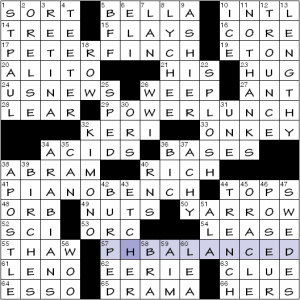
Universal • 7/1/20 • Wed • “Chemical Equivalents” • Jasper • solution
- 57aR [Chemically neutral, or a hint to 17-, 29- and 41-Across] PH BALANCED. That is, those entries start with P and end with H, which to me doesn’t seem particularly relevant to the thematic conceit.
- 17a. [Best Actor winner for “Network”] PETER FINCH.
- 29a. [Where meals and deals go down] POWER LUNCH.
- 41a. [Support for a key player?] PIANO BENCH.
To bolster the theme, row 8 consists of the paired 34a [They turn blue litmus paper red] ACIDS and 36a [They turn red litmus paper blue] BASES. From what I recall of chemistry, litmus paper is white; acids and bases will turn it red or blue, respectively.
Aside from not being sold on the theme, I was irked by some glaring yet avoidable duplications. 14a [Ancestry.com diagram] TREE, 39d [Trees in a Frost poem] BIRCHES. Something like [Bark canoe sources] could’ve worked. Then there’s 8d [Nutlike Chinese fruit] LYCHEE with 49a [Banana bread additions] NUTS. I don’t even know what “nutlike” is doing in the clue for LYCHEE; the fruit is soft and fleshy, not hard and dense like nutmeat. The fruit’s seed—which is most analogous to a nut—is not edible (of course not all nuts are edible, but I’m invoking the culinary sense, trying to find a way to make this clue rational). Perhaps it’s that litchi fruit looks vaguely like an acorn and similar nuts? Not sure. Regardless, in sum, “nutlike” is wholly unnecessary in the LYCHEE clue, and introduces another major duplication to the crossword.
 {Going through the clues}
{Going through the clues}
- Apologies for continuing the negative strain, but this is the next thing that registered with me: 18d [Column’s opposite] ROW. Opposite?! Complement at best, I’d say.
- 23a [The “O” in XO] HUG. A single iteration of XO looks to me like the ‘extra old’ designation for cognac rather than an epistolary kiss and HUG.
- 50a [Herb with white flowers] YARROW.
- 21a/66a [Towel possessive] HIS / HERS. Have seen THEIRS/THEIRS sets, as well as THEIRS/ALSO THEIRS. Then there’s this, which I’m not sure exists beyond photoshoppery. Were I to do this, the towels would just have MINE on them. Anyway, the binary here seems to echo the acid test of the theme.
- 35d [“What more __ I say?”] CAN.
Ella Dershowitz’s AVCX, “Hybrid Vehicle” — Ben’s Review

AVCX 7/1/2020 – “Hybrid Vehicle”
Today’s AVCX is another guest appearance from Ella Dershowitz, with guest editing from Paolo Pasco, with a 3.5/5 difficulty rating. Let’s dive right in:
- 17A: “My goodness!” + spicy condiment often paired with chicken — HOLY BEEFALO SAUCE
- 23A: Unexpected winner + striped Little Debbie snack — DARK ZORSE CAKE
- 53A: Circus barker + golf star discussed in David Epstein’s “Range” — SEA LIGER WOODS
- 62A: Much-memed Twitter error image + butterfly stroke component — FAIL WHOLPHIN KICK
- 39A: Game it feels like everyone’s been playing in quarantine … or, literally, a feature of this puzzle’s theme answers — ANIMAL CROSSING
Have you been playing ANIMAL CROSSING this summer? I haven’t, but I’ve enjoyed the memes/videos of other people playing, and this is a nice riff on the name. Each answer is two phrases with the name of an animal – HOLY COW and BUFFALO SAUCE, for instance – where the animals have been replaced with a hybrid of those two animals. A cross of a COW and a BUFFALO is a BEEFALO, so 17A is HOLY BEEFALO SAUCE. 23’s combo of DARK HORSE and ZEBRA CAKE gives us DARK ZORSE CAKE, 53A’s SEA LION and TIGER WOODS gives SEA LIGER WOODS, and 62A combines FAIL WHALE and DOLPHIN KICK to produce FAIL WHOLPHIN KICK. This theme was a lot of fun.
https://www.youtube.com/watch?v=Zmy0lMV7-tM
ANIMAL CROSSING also has music from KK Slider.
Elsewhere in the fill:
- Of all the things I’ll miss not going to/experiencing this year, I’m really missing the annual listing of new foods at the Minnesota STATE FAIR (“Place for ferris wheels and kettle corn”). They truly are innovators of fried food on sticks.
Happy Wednesday, All!
Natan Last’s New Yorker crossword – Rachel’s writeup
Hellooooo team. I am *exhausted* from several sleepless weeks of puppy crate training, but I’ve got some stuff to say, so let’s see how this goes! The outline of this post is thus: (1) Staircase entries (they’re great!) (2) Other notable entries (also great!) (3) A larger point about gender equity in puzzles (it’s not a new point, but one I want to make). Here we go!
I really enjoyed the central staircase. HOLLABACK GIRL is a fun song and a fun entry (although, in searching for the video below, I remembered how Gwen Stefani used to appropriatively employ the Harajuku Girls as background dancers for a while, which further googling revealed has already been extensively analyzed as problematic so I won’t do that again here). Other staircase entries GIVE IT A MINUTE [Be patient!] and WATER DROPLETS [Dew, essentially] are also solid, and I am always here for a long colloquialism.
Other notable long entries include HI-TOP FADE, OLIVE PITS, LOCAVORE, MAGIC LAMPS, and PATRIARCHY. I am particularly amused by the clue on OLIVE PITS [Tapenade maker’s throwaways], but I love the bell hooks clue for PATRIARCHY [“___ has no gender”: bell hooks], which brings me to my final point for today.
In Monday’s post, I noted the gender breakdown of the puzzle, for what I think is the first time in my reviews. I received a note from a reader that gently REPROVEd me for having done this, for the first time, on one of Kameron Austin Collins’s puzzles, as it gave the impression that I was holding a constructor of color to a higher standard than other constructors. I want to be clear that that was in *no way* my intention; it was the product of an ongoing conversation I’ve been having with another constructor about gender and the New Yorker, which had led me to the decision that I wanted to start keeping track of gender representation in all of these puzzles. I want to apologize to Kameron for not recognizing how it might look to start that project on the day his puzzle came out, particularly because he has a constructing history full of strong representation of women in his puzzles and has personally been vocal about the importance of representation in puzzles more broadly. As has Natan.
But bell hooks’ quote sums up exactly *why* I want to start keeping track of these things in New Yorker puzzles: the New Yorker has a female editor and, now, a majority female constructing roster. And yet. And yet. And yet we still consistently see more men in these puzzles than women. Take today’s puzzle:
- Men: Levon HELM, LEVAR Burton, Louis Armstrong, Queen (I’m counting the whole band as one dude), Macduff, Hulk, Silas Marner, Jerry and David(??), ERNST Stavro Blofeld, Edward Snowden (12)
- Women: ERICA Jong, Gwen Stefani, bell hooks, George Eliot, Kristen WIIG (5)
Moreover, to the Queen point, Gwen Stefani’s HOLLABACK GIRL, which could have been clued in literally hundreds of ways, was clued in reference to a Queen song. Is it an interesting factoid? Sure. I listened to the song again to hear the lyric “Another One Bites the Dust,” and that was an experience I’m glad I had. But so many other things could also be said about this song that don’t involve bringing in men (see, e.g., above re: cultural appropriation). And on its own, this clue is not bad! My point is that the incremental accumulation of male-centered cultural reference points results in a puzzle that skews male 12:5. And then the male-skewed puzzles accumulate, and so on. I don’t mean to belabor this point, but I think it’s important to point out that although crosswords have come far in terms of constructor and editor representation, the work is not finished. I’ll continue to track this, probably in a bullet point under “A Few More Things,” going forward.
ANYWHO, back to this puzzle: I enjoyed it! Natan’s cluing voice is one of my favorites, and the grid is well-made and the fill is gorgeous— even the three-letter entries are all solid. Overall, lots of stars from me.
Bill Zagozewski’s LA Times crossword – Gareth’s summary
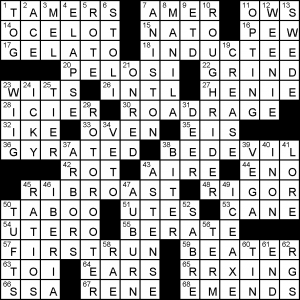
LA Times
200701
Quite a simple theme type at heart – two word phrases of the sort R…/R…, four of them – but with the wrinkle of them intersecting at the second R and RRXING as a revealing answer. We get a historical ROUGHRIDER intersecting ROADRAGE and a ROTOROOTER intersecting RIBROAST.
FIRSTRUN is by far the best entry in the puzzle; in the language, but something unlikely to be found in dictionaries. On the other hand, ASTENSE is an entry so contrived it should cause a puzzle to be remade.
Gareth
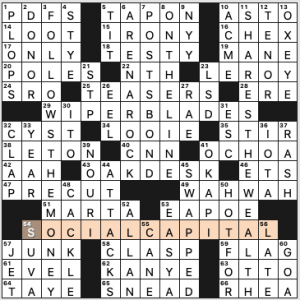
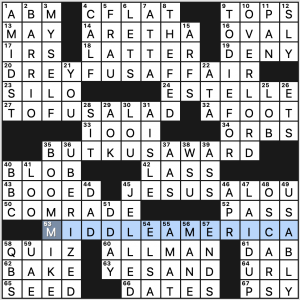
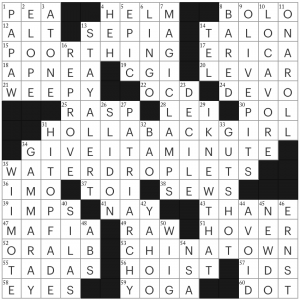
Speaking of names, I found the “r” in the Nouri/Marta crossing a killer.
I’m surprised at the low rating for the NYT puzzle — I thought it was clever and original.
I also approve of the clue “Unspecified degree” for NTH, which is most often erroneously clued as highest power or some such.
It’s always surprising and disappointing to find that a constructor misuses the word “comprise.” LAT, 46 down.
If it’s not a self-published puzzle, the responsibility lies with the editor, who either missed a constructor error or introduced a mistake.
Thanks, good point. I solve via hard copy (Washington Post) and the editor’s identity isn’t shown. It was Rich Norris.
I found the NYT to be tough but very clever. Don’t get why Amy says “I like the theme contents okay, but not the unusual layout in L/R symmetry. Having a 9-letter themer sandwiched between two nonthematic 9s is awkward,,,,,,,,” It’s different but not awkward, at least to me.
NYT – Favorite badass 80s woman of rock? Tough choice. This week it’s Annie Lennox.
Re: NYT
Allow me to push back on EA POE being an entry constructors need to delete from their lists. It’s not a great entry, but I think it’s legitimate. The website for the Edgar Allan Poe Society is http://www.eapoe.org, it Googles decently (around 650K hits) and you can find the abbreviation elsewhere “in the wild.”
For example, this headline in the Baltimore Sun: In Baltimore and Boston, competing claims to E.A. Poe.
And this novel: The Facts in the Case of E.A. Poe.
Again, it’s not great and should be avoided if possible, but it’s acceptable in a pinch, in my opinion.
Rachel’s comments today are definitely appreciated, and vigilance toward gender representation in puzzles, especially at the level of clues, is urgent. With respect, it’s clear to me that we also need to get a bit more vigilant over an important factor being overlooked here–a factor routinely overlooked in the ongoing conversation about gender and crosswords, from what I’ve seen on this blog and in the conversation at large.
LEVAR Burton, Louis Armstrong, ERICA Jong, bell hooks, Yahoo! cofounder Jerry (Yang): three of these people are men, but–just as importantly, I would think–none of them are white. And while for some it may make sense to count the band Queen as “one dude,” the most prominent of those dudes, Freddie Mercury–born Farrokh Bulsara–was an Indian man of Parsi descent. He was also a gay man who very publicly died of AIDS. Folding Freddie into some indeterminate “Dude”-blob with his white bandmates willfully neglects these nuances. And doing so in order to make a point on behalf of “women” sincerely strikes me as a missed opportunity–a precise and convincing example of why the term “white feminism” exists.
If we’re really going to talk about the problem of identity and representation in crosswords, if we’re really going to pretend it can be boiled down to a numbers game and use those tallies to hold people accountable on a puzzle-by-puzzle basis–a strategy I don’t find helpful, to be honest–we’re going to need to talk seriously about why gender has become the sole metric in these conversations. About why, for example, it’s the only identity category Rachel has even thought it necessary to start tallying up on this blog.
Women are underrepresented in crosswords. I would argue that, historically, non-white people are comparably underrepresented, but that feels generous: I think there are even fewer of us. And the majority of the non-white constructors working long-term, like myself, are men, leaving non-white women almost completely biting the dust, as it were.
And so, when these conversations play out, you get the familiar problems, the usual talking past each other. It was beautiful when, commemorating Women’s History Month this March, the New York Times ran a full week of puzzles by women. It was also hard not to notice that the vast majority of those women (all but 1?) appeared to be white. And it was hard for me not to bear in mind that, though Women’s History Month follows Black History Month on the calendar, the idea of a comparable week of black constructors to commemorate the latter, for a project that draws entirely from a pool of previously-published NYT constructors, immediately strikes one as unfeasible. Even if weren’t, even if that “black week” had happened, how many of those constructors would have been women? And would the people celebrating the racial advancement there, the way they celebrated the advancement for women in March, have similarly overlooked this glaringly obvious omission?
When Sally Hoelscher’s fantastic February 17 puzzle was written up on this blog earlier this year, it was noted that all but one of the proper nouns in her puzzle was intentionally clued as a woman–a real accomplishment, truly a breath of fresh air. The entry clued as a man, by Shortz and co., was DEE, clued via black actor Billy __ Williams. It was urgent to point the gender disparity of this clue out in a puzzle that so intentionally avoided male proper nouns. The fact that non-white people like Billy DEE aren’t exactly some hyper-represented category, the fact that it’s uncomfortable to see a non-white person’s inclusion in the puzzle get complained about–these things still don’t mitigate the wise point that was made. The clue should and just as importantly COULD have been a woman. Period.
What disappointed me, though, was that in ignoring race altogether while touting that this blog has a “feminist POV,” and in suggesting alternatives like the white actress Sandra DEE, no one seemed to think about the racial element at play here. No one suggested, say, the black actress and civil rights legend *Ruby* DEE–and no one pointed out that the appearance of Billy DEE fully doubled the number of non-white names in the puzzle. For me, this makes his inclusion as the “only man” a little more complicated. At the very least, it seems worth mentioning if we’re going to make it our business to call these things out.
But this is also why I think tallying these things up to call specific puzzles out isn’t really the best approach–not when it implicitly gives a full, inclusive proper name (where the diversity is built into the fabric of the puzzle) the same value as a neutral entry whose clue just so happens to check this or that identity box. And not when some people have entire bodies of work worth considering, and patterns of behavior, and general constructing philosophies that try to account for these things while also, from puzzle to puzzle, accounting for the other forms of diversity available to us. The circumstances of an individual puzzle can vary, in other words. But I think we all know, broadly speaking, whose puzzles make a point of including women or non-white people and culture, in the same way that we know whose puzzles aggressively include, say, pop culture, or little-to-no “culture” at all.
That last category, the no-culture crew, usually deploys a style that takes white guys’ names for granted, because white guys are ostensibly neutral. This is a group that also has more than its share of our community’s most lauded constructors. Lauded on these and other pages within the last week, even, and frequently held up as the industry standard. Lauded–per usual–with a minimum of critique on the above grounds. If we were really serious about this conversation, wouldn’t we start by revising our own gold standard? Wouldn’t we start with them?
Going to read this over multiple times. Let’s all do so. Thank you for your time and insight, Kameron.
Thanks for your thoughtful comments. I’ve also found the gender counts of crossword entries to be reductive and not terribly helpful. For decades ONO wasn’t anything more than an overused piece of short fill; now it’s viewed as an asset – she checks off a couple of rows on the bingo board, after all.
Look up reviews from this blog from the early 2010s – Amy was counting up all the proper nouns in a puzzle, and if it passed some threshold (was it 16 or 17 in a 15×15 grid?) this was deemed as a flaw, as proper nouns very often are “you know them or you don’t” and many solvers get tripped up by them. I consider this to be sage advice. Now it seems as long as the “right” proper nouns are used, this is seen as laudatory social progress, killer crossings be damned. If these proper nouns are just a slew of white dudes, however, we’re told how wrong the constructor was for having such a narrow worldview reflected in their puzzle.
I enjoy puzzles from constructors who reflect different cultures in their grids. I also enjoy puzzles that focus on minimizing proper nouns and instead focus on interesting common words/phrases. I don’t think I have to choose which of these approaches is more valid than the other. Diversity in constructors’ approaches is a good thing. One thing that is off-putting to me is an obvious reliance on software/wordlists – there are puzzles, particularly themelesses, that just scream “computer assistance” and it makes the puzzle seem much more detached and less personal. But I realize that this isn’t a universally shared opinion and I’m not interested in changing others’ minds on it. Different strokes, I guess. That’s why I continue to enjoy solving puzzles.
I appreciate this discussion and the constructors who are working to address these issues in their puzzles.
It bears noting that “killer crossings” are in the eye of the beholder. If there’s a name that women, say, or Black solvers are more likely to know right off the top of their head, it’s an entirely fair crossing to them. Like, if the BEYHIVE were in a grid and there’s a “could be E, could be Y there” crossing for the third letter, it’s not remotely a killer crossing to probably 150 million Americans, whereas any name crossing AMAHL hits a very particular little piece of cultural literacy that really isn’t broadly known outside of hardcore solvers.
14 seems to be the maximum number of names before a grid might trigger vociferous complaints from the no-namers. 12, doable. 18, it stands out.
Wordlist autofill constructors bug the ever-living $%# out of me. We can tell when you didn’t actually take any care with your fill, especially when it would be so easy to change a letter or two and have much better fill. Expect better from yourselves!
Thanks for your essay, Kameron.
Last fall, Nam Jin Yoon posted in the FB group Crossword Puzzle Collaboration Directory, saying “Do any of you use a version of the “Bechdel test” for crossword constructing? I have a really basic rule where I give myself a point for every name in my grid / clues that isn’t a straight, white man, and subtract a point for every name that is. If I end up with negative points, then I’ll redo the grid. It’s a fairly forgiving rule (since straight white men only make up, at most, a third of the U.S. population), but it’s surprising how many of my grids ended up with negative points.” His method is wonderfully inclusive and I like it. He doesn’t spell out “isn’t cis” in his criteria, but if there were a trans man who’s straight and white in the puzzle, I wouldn’t consider his presence a strike against inclusiveness.
btw, Kameron, Erica Jong is white (Jewish). She picked up the surname from a Chinese American husband.
Thanks for your thoughtful comment Kameron and thanks for pointing me to this thread Amy.
I still do that version of the Bechdel test I posted about last year on my own grids, mostly as a quick and dirty check against my own unconscious biases (and against my semi-conscious pandering). I stick with individual names to keep things simple and to avoid splitting hairs, though it’s worth noting that Natan’s grid would “pass” my own particular check. (It’s also just a fantastic puzz.)
I think this kind of tallying can still be useful in crossword reviews. Yes, the test is crude and reductive for all the reasons Kameron correctly pointed out. But at its best, the test can make the lack of diversity in puzzles more tangible to constructors, solvers, and editors who might otherwise gloss over it. At least one white male constructor has noted in his constructor notes that he’s tried to be more inclusive in his puzzles after the gender disparity in one of his earlier puzzles was tallied and pointed out on this blog.
I agree with Kameron that some of the more lauded members of the “no-culture crew” (love it!) seem to get a pass here and in other blogs. The crosswords that present as neutral are the very ones I’d love to see some more tallies for.
(Amy–I do put trans men on the under-represented side of the tallies.)
Re: WSJ, the USA resides at the EXACT center of each theme entry, not just within the entry.
Good catch which I should have caught, too. That definitely limits the number of potential theme entries.
pannonica,
When I was a kid, the only form of litchi we ever saw was the “litchee nut.” Fresh ones hadn’t hit the New York market yet but every Chinatown grocery sold boxes of the dried fruit as litchee nuts. The fruit shrinks in drying so the papery “shell” (exocarp) does make it appear nutlike in that form. They are delicious, btw. They take on a smoky, plummy flavor that’s more complex than the fresh fruit, although I love them too. I haven’t seen “litchee nuts” in years. I don’t know if they’re still around in New York or whether they just don’t import them anymore. I think the drying process uses some chemicals which might be banned by the FDA. At least I wouldn’t be surprised.
But the whole dried fruit was the “nut,” not the seed. Of course we realized it wasn’t a nut, but then neither is a peanut.
Thanks. Something along those lines was stirring in my mind.
Hear Hear Kameron!
Dave! You solve the LAT on paper! You are my friend for life!
Might need to ad DEVO as another dude in the New Yorker puzzle. That said, I really liked it! Interesting seeing two strings of WII (WIIMOTE and WIIG).